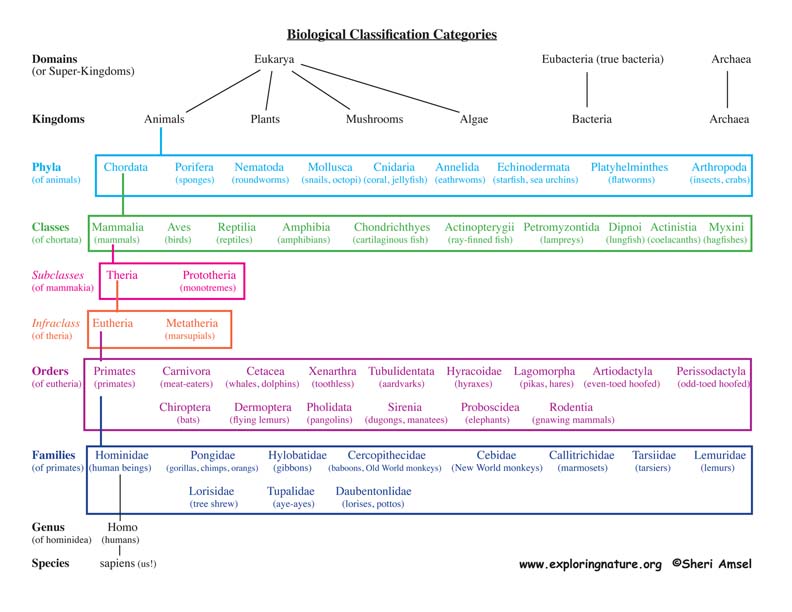

Posted on 06/10/2018 2:20:23 AM PDT by GonzoII
Landmark new research that involves analyzing millions of DNA barcodes has debunked much about what we know today about the evolution of species.
In a massive genetic study, senior research associate at the Program for the Human Environment at Rockefeller University Mark Stoeckle and University of Basel geneticist David Thaler discovered that virtually 90 percent of all animals on Earth appeared at right around the same time.
More specifically, they found out that 9 out of 10 animal species on the planet came to being at the same time as humans did some 100,000 to 200,000 years ago.
"This conclusion is very surprising," says Thaler, "and I fought against it as hard as I could."
(Excerpt) Read more at techtimes.com ...



If a day is equal to 500 million years!
Natural selection is real and changes species but doesn’t explain the origins of species.


Rush is outstanding when it comes to political analysis. However he is quite inept when it comes to technical subjects. It is painful to listen to him say things like this.

Imagine that.
From an physicist.....
Gerald Schroeder
Dr. Gerald Schroeder earned his BSc, MSc and double-Ph.D. in Nuclear Physics and Earth and Planetary Sciences at the Massachusetts Institute of Technology, where he taught physics for seven years.
The Age of the Universe
List in numerical order species that you Say evidence evolution or that you think argue for any credence to “ evolution”.
Religious views and scientific theories Edit
His works frequently cite Talmudic, Midrashic and medieval commentaries on Biblical creation accounts, such as commentaries written by the Jewish philosopher Nachmanides.
Among other things, Schroeder attempts to reconcile a six-day creation as described in Genesis with the scientific evidence that the world is billions of years old using the idea that the perceived flow of time for a given event in an expanding universe varies with the observer’s perspective of that event.
He attempts to reconcile the two perspectives numerically, calculating the effect of the stretching of space-time, based on Einstein’s general relativity.[7]
Namely, that from the perspective of the point of origin of the Big Bang, according to Einstein’s equations of the ‘stretching factor’, time dilates by a factor of roughly 1,000,000,000,000, meaning one trillion days on earth would appear to pass as one day from that point, due to the stretching of space.
When applied to the estimated age of the universe at 13.8 billion years, from the perspective of the point of origin, the universe today would appear to have just begun its sixth day of existence, or if the universe is 15 billion years old from the perspective of earth, it would appear to have just completed its sixth day.[8]
Antony Flew, an academic philosopher who promoted atheism for most of his adult life indicated that the arguments of Gerald Schroeder had influenced his decision to become a deist.[9][10]
His theories to reconcile faith and science have drawn some criticism from both religious and non-religious scientists, and his works remain controversial in scientific circles.[11][12]
https://en.m.wikipedia.org/wiki/Gerald_Schroeder#Religious_views_and_scientific_theories
Time dilation makes sense to me.
Yes, according to Einstein’s Relativity theory, a clock in motion will appear to tick out time more slowly than an identical stationary clock at your side.
General Relativity states that acceleration and the effects of gravity are ‘equivalent’. In other words, time appears to tick more slowly in strong gravitational fields (from an outside observer’s point of view).
In fact, it has been verified that a clock on the surface of the earth ticks out time more slowly than an identical one high above the surface (where gravity is weaker).
A similar effect occurs via spacetime stretching due to universal expansion. Gravity, in a sense, (also) causes spacetime to stretch. Time, according to a clock caught in a strong gravitational field, will appear to slow down, from an outside observer’s point of view.
GPS technology takes 2 of these effects into account.
1) the difference in time at the surface vs high above the surface where the satellites orbit.
2) the difference in time due to the high rate of speed of the satellite vs the ground (stationary).
Surprisingly, to me when I learned, is that, for GPS calculations, the effects of gravity win out over the high rate of motion. Each actually have opposing effects on time. ie, the ground-based person with the GPS device experiences more time dilation (due to gravity) tan the GPS satellite racing across the sky.
tan the GPS satellite racing across the sky = than the GPS satellite racing across the sky.
I venture to assert that this observation holds true for almost any given point in Earth's 4.6-billion-year history, and that, throughout the, say, Mesozoic Era, too, 90% of all Earth's animal species had arisen at roughly the same time (i.e., plus/minus a million years).
In other words: There is nothing "special" about the Present (except that, of course, human beings have exerted a far greater force upon the biosphere than almost any other species).
Regards,
I didn’t realize that the differences would show up at such slow rates of speed.
I thought they’d need to be much faster.
People often ask me “What good is Relativity?” It is a commonplace to think of Relativity as an abstract and highly arcane mathematical theory that has no consequences for everyday life. This is in fact far from the truth.
Consider for a moment that when you are traveling in a commercial airliner, the pilot and crew are navigating to your destination with the aid of data from the Global Navigation Satellite System (GNSS), of which the United States NAVSTAR Global Positioning System (GPS for short) is the most familiar component.
In fact, “GPS” is often synonymous with satellite navigation, even it is now one of three global satellite navigation systems in operation along with the Russian GLONASS and EU Galileo satellite systems (they will be joined by the Chinese BeiDou-2 system when it expands to global scale in the early 2020s), While this article is specifically about NAVSTAR GPS, the basic operating principles are similar across the various GNSS implementations.
GPS was developed by the United States Department of Defense to provide a satellite-based navigation system for the U.S. military. It was later put under joint DoD and Department of Transportation control to provide for both military and civilian navigation uses, and has become a part of daily life.
Most recent-model cars are equipped with built-in GPS navigation systems (increasingly as standard equipment), you can purchase hand-held GPS navigation units that will give you your position on the Earth (latitude, longitude, and altitude) to an accuracy of 5 to 10 meters that weigh only a few ounces and cost around $100, and GPS technology is increasingly found in smartphones (though not all smartphones derive location information from GPS satellites).
The nominal GPS configuration consists of a network of 24 satellites in high orbits around the Earth, but up to 30 or so satellites may be on station at any given time. Each satellite in the GPS constellation orbits at an altitude of about 20,000 km from the ground, and has an orbital speed of about 14,000 km/hour (the orbital period is roughly 12 hours - contrary to popular belief, GPS satellites are not in geosynchronous or geostationary orbits).
The satellite orbits are distributed so that at least 4 satellites are always visible from any point on the Earth at any given instant (with up to 12 visible at one time). Each satellite carries with it an atomic clock that “ticks” with a nominal accuracy of 1 nanosecond (1 billionth of a second). A GPS receiver in an airplane determines its current position and course by comparing the time signals it receives from the currently visible GPS satellites (usually 6 to 12) and trilaterating on the known positions of each satellite[1].
The precision achieved is remarkable: even a simple hand-held GPS receiver can determine your absolute position on the surface of the Earth to within 5 to 10 meters in only a few seconds. A GPS receiver in a car can give accurate readings of position, speed, and course in real-time!
More sophisticated techniques, like Differential GPS (DGPS) and Real-Time Kinematic (RTK) methods, deliver centimeter-level positions with a few minutes of measurement. Such methods allow use of GPS and related satellite navigation system data to be used for high-precision surveying, autonomous driving, and other applications requiring greater real-time position accuracy than can be achieved with standard GPS receivers.
To achieve this level of precision, the clock ticks from the GPS satellites must be known to an accuracy of 20-30 nanoseconds. However, because the satellites are constantly moving relative to observers on the Earth, effects predicted by the Special and General theories of Relativity must be taken into account to achieve the desired 20-30 nanosecond accuracy.
Because an observer on the ground sees the satellites in motion relative to them, Special Relativity predicts that we should see their clocks ticking more slowly (see the Special Relativity lecture). Special Relativity predicts that the on-board atomic clocks on the satellites should fall behind clocks on the ground by about 7 microseconds per day because of the slower ticking rate due to the time dilation effect of their relative motion [2].
Further, the satellites are in orbits high above the Earth, where the curvature of spacetime due to the Earth’s mass is less than it is at the Earth’s surface
A prediction of General Relativity is that clocks closer to a massive object will seem to tick more slowly than those located further away (see the Black Holes lecture). As such, when viewed from the surface of the Earth, the clocks on the satellites appear to be ticking faster than identical clocks on the ground. A calculation using General Relativity predicts that the clocks in each GPS satellite should get ahead of ground-based clocks by 45 microseconds per day.
The combination of these two relativitic effects means that the clocks on-board each satellite should tick faster than identical clocks on the ground by about 38 microseconds per day (45-7=38)! This sounds small, but the high-precision required of the GPS system requires nanosecond accuracy, and 38 microseconds is 38,000 nanoseconds. If these effects were not properly taken into account, a navigational fix based on the GPS constellation would be false after only 2 minutes, and errors in global positions would continue to accumulate at a rate of about 10 kilometers each day! The whole system would be utterly worthless for navigation in a very short time.
The engineers who designed the GPS system included these relativistic effects when they designed and deployed the system. For example, to counteract the General Relativistic effect once on orbit, the onboard clocks were designed to “tick” at a slower frequency than ground reference clocks, so that once they were in their proper orbit stations their clocks would appear to tick at about the correct rate as compared to the reference atomic clocks at the GPS ground stations. Further, each GPS receiver has built into it a microcomputer that, in addition to performing the calculation of position using 3D trilateration, will also compute any additional special relativistic timing calculations required [3], using data provided by the satellites.
Relativity is not just some abstract mathematical theory: understanding it is absolutely essential for our global navigation system to work properly.
http://www.astronomy.ohio-state.edu/~pogge/Ast162/Unit5/gps.html
Here's the key fact that everyone needs to understand: we're playing word-definition games here, beginning with, "what is a species" and "when or how does a certain species become not that species?"
So when they say, "90% of 'species' originated from 100,000 to 200,000 years ago," all that means is natural genetic drifts, from one generation to the next can accumulate enough changes such that after, say, 100,000 to 200,000 years we define them as a new "species".
So ask those same scientists, "fine, 100,000 to 200,000 years for current species, how many years since each new genus?"
Answer: around 1 million years.
What about new biological families?
Answer: around 10 million years.
What about new biological orders?
Answer: about 50 million years.
What about new biological classes?
Answer: maybe 150 million years.
Etc., Etc.
Point is, this study does not imply there were no species before 100,000 to 200,000 years ago, only that our definition of "species" last about 100,000 to 200,000 years before, ahem, changing into something we define as a different "species".


Their methodology in the PDF link reads like an opinion poll and the whole bit about species is a side issue in the paper - they are really looking at mitochondrial DNA: Why should mitochondria define species?
srmorton: "I heard him say that.
I rarely disagree with Rush, but in this case he was wrong.
The theory of evolution does not claim that man evolved from apes, but that both evolved from a common ancestor which is a very different proposition."
plain talk: "Rush is outstanding when it comes to political analysis.
However he is quite inept when it comes to technical subjects.
It is painful to listen to him say things like this."
I've heard Rush talk about evolution, infrequently and not recently, and not the argument you posted here.
Obviously Rush is sympathetic to creationism, but I've never heard him trash science to get there.
In this particular argument, the answer couldn't be simpler:
Disclaimer: Opinions posted on Free Republic are those of the individual posters and do not necessarily represent the opinion of Free Republic or its management. All materials posted herein are protected by copyright law and the exemption for fair use of copyrighted works.